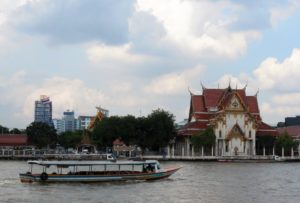
There are 20 temples located along the Chao Phraya River.
Thailand is a nation of rivers. The Chao Phraya is the main river system and there are 5 tributaries that branch tree-like up into Northern Thailand. Bangkok’s being located on the main river was one of the reasons that it was chosen as the capitol. In the 1500s under the Ayutthaya period, a canal-system was created as transportation to shorten the lengths between cities and river settlements. These cities that grew along the river system became the most densely populated regions. Today the canals are still a major source of transportation and irrigation. Bangkok has a thriving industry of river buses, taxis and ferries which are often a much faster alternative to the congested roadways. We spend a significant portion of our travel excursions on the water.
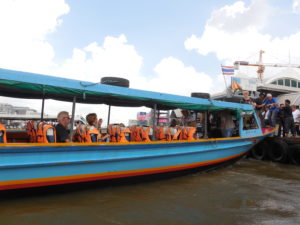
A water taxi
The river boat we are on has to wait for access through a lock and about 5 of these boats clog up the canal entrance awaiting passage. Fortunately, they cut off their motors because the diesel fumes are starting to cause hallucinations. These motors are often rebuilds from trucks that are modified for use in the boats. We have a new guide today. Her name is Kris and she is our river expert. Today we tour Bangkok from the Chao Phraya.
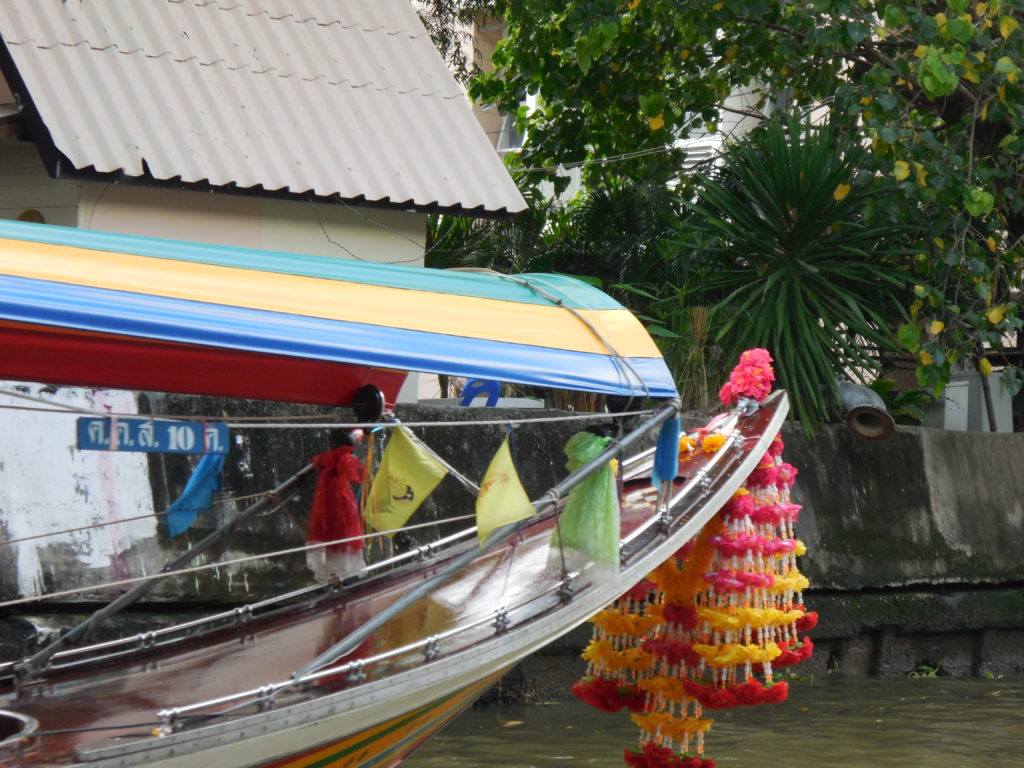
Flower offerings on the front of a longtail boat
Kris informs us that riverfront real estate is Primo in Bangkok. There is no longer any new construction allowed so property passes down through generations. We’re informed that only Thai citizens can own property in Thailand. The houses run the gamut from luxurious to shanty. Most are propped on stilts and you can see the watermarks that provide testimony to the rainy season.
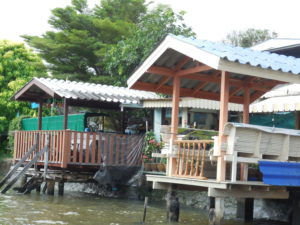
Homes on stilts
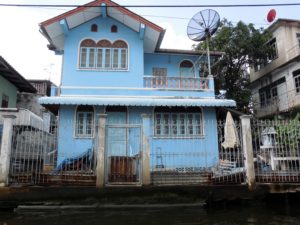
Colorful mixed style architecture
It is a hot trip on the river. I made the mistake our first day here in putting on an spf make-up foundation which proceeded to melt down my face. We travel with a small nylon backpack that contains our sunscreen, mosquito-repellent wipes, 2 micro-fiber travel towels which we put to use mopping up sweat and 2 bottles of water each. My cameras and 2 back up power chargers round out our supplies. We see daily life on the river as we pass the locals in their chores of laundry, working on their boats or scooters and other tasks. Most are friendly and smile and wave at us.
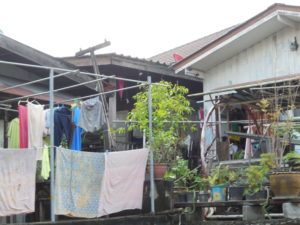
Laundry day
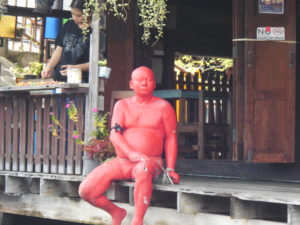
statue on a river house deck
There are a number of high rise condos a few streets back from the river affording some nice views. Kris tells us that many of the relocated ex-pats inhabit these. One of our fellow travelers is an organic farmer from California who produces wine grapes and he is also a nut for orchids. These beautiful flowers are endemic here and many houses are adorned with them. He points them out to us.
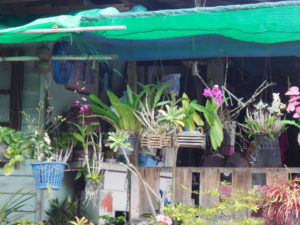
Orchids

Many homes had statuary on the decks
We approach one of the many temples along the riverside and the waters are almost clogged with the number of large catfish. Like the cats in the Old City, the Monks provide for the fish and most of them are smart enough to stay right there. A few feet downriver are fisherman lazily manning their hooks in the hopes that one of these fish is stupid enough to drift away.

Catfish in congregation in front of the temple.
Our second river excursion was a more in depth exploration of the canals as we headed to the famous floating market. This time we were in a long boat.
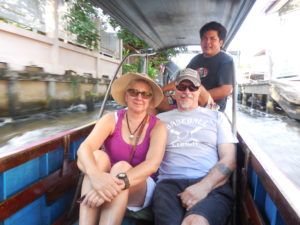
Our Captain flying through the canals.
If the Chao Phraya riverbank communities were the big city then the canal dwellers were their country cousins. It was a little reminiscent of when we toured the Louisiana bayous.
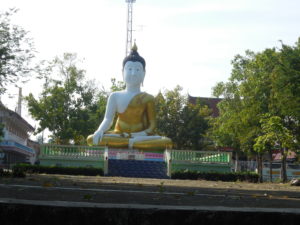
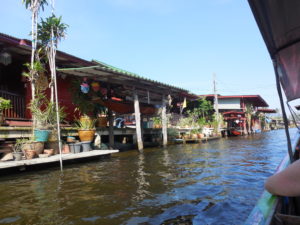
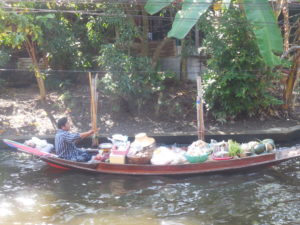
Vendor on the way to market
Our guide, Mr. O, happens to be from the village where the floating market is located. He says it’s an agricultural area that is known for producing fruits, vegetables, flowers and coconuts. Mr. O’s family were fruit farmers and he tells us that in the hierarchy of rural farmers the coconut producers were made fun of as being lazy. This is because in Thailand the coconut self-produces and requires very little tending or care. Now that the Westerners are so enamored with coconut oil, it has caused a shift in power. The coconut oil market is thriving here and more land is being relegated to the coconut palm. He takes us to a small local market that is producing coconut sugar and oil the old fashioned way. The coconut water is tapped out then the coconut flesh is removed. This is heated in metal cauldrons and rendered down to produce coconut sugar. (Think the maple candy you get when the sap is running except it tastes like coconut and is not as sweet as you would imagine.) If you continue the rendering you will end up with coconut oil.
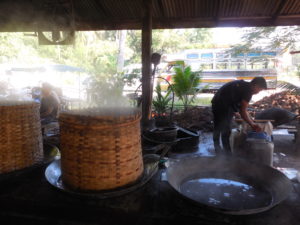
Making coconut oil
Mr. O warns us that the floating market has become a huge tourist trap but if we follow a path behind the first part of the market and take it back and across a bridge we will come to the part of the market that is still used by locals. Of course I beat feet right for the authentic part of the market. It’s not a disappointment.
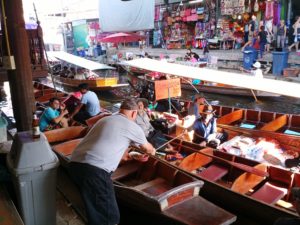
Don buying grilled pork
We descend to the dock which has a large area of tables and chairs. If you see something you want on one of the boats the vendor will place it on an oar and pass it off to you. You then place your money on the oar. Mr. O has given us some market etiquette and told us that prepared food prices are not negotiable but any goods or produce are open for discussion. We sample some savory barbecued pork being grilled on one of the boats and I have what’s being billed as coconut ice cream. It is a delicious frozen concoction of coconut served in half a coconut shell. It is so good, particularly because it’s like 99 degrees out.
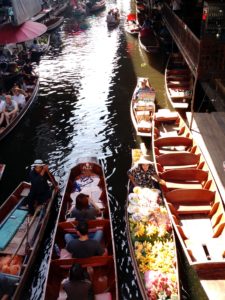
A view from the bridge
We have no qualms about eating anything in Thailand, unlike China where our guides specifically told us not to eat any street food. The streets, rivers, canals and malls are our banquet table! It is all delicious, fresh and unbelievably cheap.
The third time we hit the river is a little more up close and personal. We travel to the Kanchanaburi region close to the Myanmar border to visit the area made famous by the Death Railway. During WWII the Japanese were seeking to have a transportation route from Burma to India. They used captured POWs (mostly, Aussie, British and Dutch) to construct the railroad. About 9000 perished under the deplorable and harsh jungle conditions. The Bridge on the River Kwai is a fictionalized story that was a major movie. We were visiting the real bridge and drifted down the river Kwai on a bamboo raft.
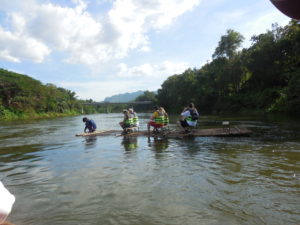
Rolling on the River Kwai
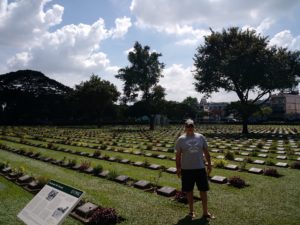
The POW cemetery

The Bridge on the River Kwai
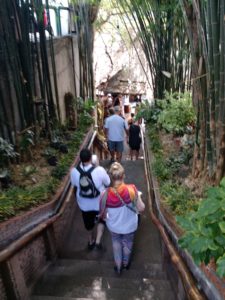
Headed down to a floating restaurant.
The final river voyage we took was upscale as we had luncheon on a cruise that took us from the Ayutthaya ruins back down to Bangkok. Big boat, air-condtioned with alcohol. What’s not to love?
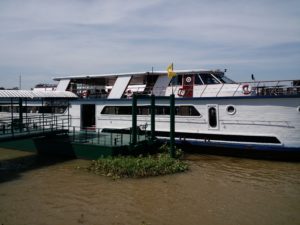
Next: Night Life
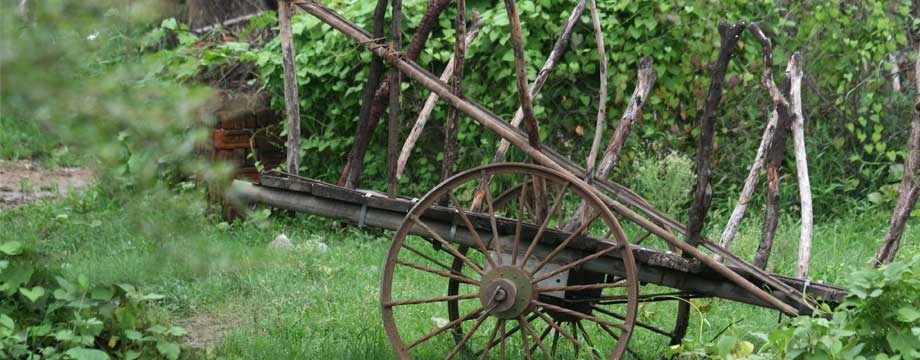
 Follow
Follow
2 Responses to The Thailand Tales: episode 4